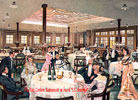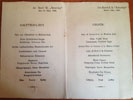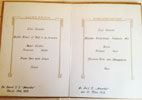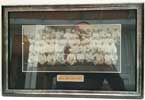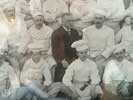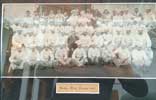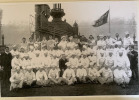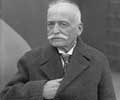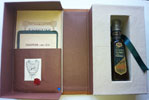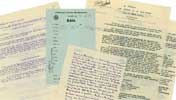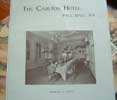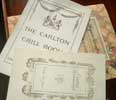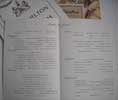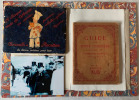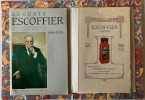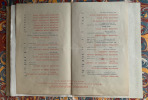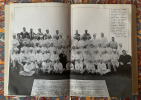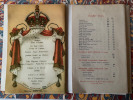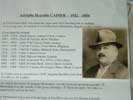Menu of a banquet for Escoffier at the Palais d'Orsay.
In homage to Maitre Auguste Escoffier by the society of the 'Cuisiniers de Paris'. for the occasion of his promotion to ‘Officier de la Legion d’honneur’ on March 22nd, 1928 at the Orsay Palace.
A four page menu within covers, with a print of a painted portrait of Escoffier (courtesy of the Foundation A. Escoffier at Villeneuve-Loubet), plus the wine list and menu. Very clean on white handmade paper with a red place ribbon and untrimmed edges, with the outside covers lightly age browned at the edges. A very handsome and unique item. The menu comprises: Creme de Volaille. Consomme Riche. Saumon de la Loire braise au Clicquot. accompagne: d'ecrevisses de l'Issole. Baron de Bebague. garni aux: primeurs de la Provence. Coq en Pate Palais d'Orsay. avec: une Salade Rosettte. Glace Legion d'Honneur. Roseaux pralines des bords du Loup. Corbeilles de Fruits. Friandises. The Wine list comprises: Five vintage Champagnes from 1919 and 1920. A Medoc et Graves. A Bitard Montrachet. A La Tache Monople 1918. The menu is housed in a handsome cardboard folder covered with red marbled paper and a label on the front cover.
- From 1890 to 1920, Escoffier took over the management of the kitchens in many luxurious & prestigious hotels like The Savoy Hotel and The Carlton Hotel in London and Ritz Hotel in Paris. For almost thirty years, he served many of the most famous people of the time, creating for them unique dishes that became renowned, even to this day. After he left London in 1920, Escoffier returned to Monte Carlo and undertook a very active retirement. He never ceased writing culinary books until his death in 1935. Due to the gratitude and unforgettable memory of Escoffier, people, including his best friends and colleagues in London and Paris, created the Auguste Escoffier Foundation. This eponymous museum was established in 1959 in the house where he was born. Mon. Raymond Poincaré was a French conservative statesman who served as Prime Minister of France on five separate occasions and as President of France from 1913 to 1920. For Escoffier's work in promoting French cuisine, President Poincaré personally presented him with the cross of ‘The Légion d'honneur’ or ‘The Ordre national de la Légion d'honneur‘. This is a French order established by Napoleon Bonaparte, First Consul of the First Republic, on 19 May 1802. Escoffier in 1919, was the first chef to receive such an outstanding award. On March 22nd, 1928 he was promoted to the highest French honour as an ‘Officier de la Legion d’honneur’ and again became the first chef to have received this distinction. He was presented his medal by President Edouard Herriot at the Palais d'Orsay. The ceremony was followed at the Palais by, quote “a remarkable banquet" with Escoffier as the guest of honour. In the last b/w photograph below, Escoffier can be seen shaking President Herriot's hand at the Palais as he is leaving. He is also surrounded by the brigade of chefs that cooked the banquet. This extremely rare menu is from that memorable occasion.


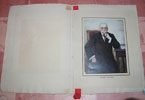
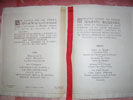

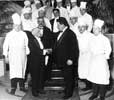
click on image to enlarge

Ephemera category
ref number:
11113 